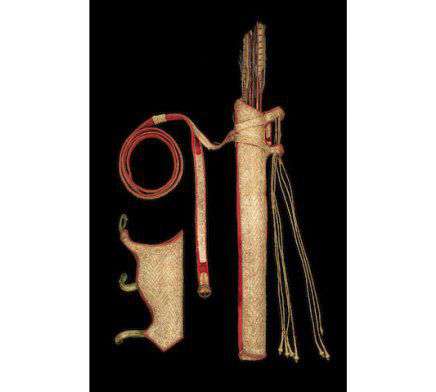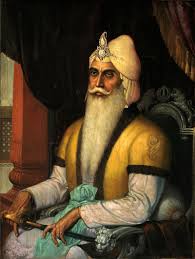 LONDON: A gold-thread-embroidered, velvet-clad leather bow and arrow holder made for Maharaja Ranjit Singh leads a set of Indian treasures to go under the hammer in London later this month.
LONDON: A gold-thread-embroidered, velvet-clad leather bow and arrow holder made for Maharaja Ranjit Singh leads a set of Indian treasures to go under the hammer in London later this month.
The exquisite quiver, believed to have been made for ceremonial purposes rather than to be used in battle by the Sikh emperor known as the Lion of Punjab is estimated to fetch between 80,000 pounds and 120,000 pounds when it comes up for auction at the Bonhams Islamic and Indian Art sale on October 23.
“This is a wonderful piece from the fabled Treasury of Lahore, and all the circumstantial evidence points to it being the one made in 1838 for Ranjit Singh, Lion of the Punjab the state’s greatest and most famous leader,” said Oliver White, Bonhams Head of Indian and Islamic Art.
“The quiver was made purely for ceremonial purposes, and appears to have been rarely worn. As a result, it is in excellent condition,” he notes.
According to Bonhams historians, archery played an important role in Sikh military culture. Long after bows and arrows were superseded by more modern weaponry, they retained a ceremonial and symbolic significance, especially among the nobility who would appear in public wearing an embroidered quiver at their side.It is believed that the Maharaja commissioned a quiver in 1838 to wear at the wedding of his eldest son and heir, Kharak, and he appears to be wearing the one in the sale or one extremely similar to it in a painting of the same year by the French artist Alfred de Dreaux, now in the Louvre Museum in Paris, the auction house said.
Ranjit Singh died in 1839, plunging the Punjab into instability which prompted the East India Company to invade and annex the state. At the conclusion of the First Anglo- Sikh war in 1846, the victorious Company acquired the Royal Treasury in Lahore, including the famed Koh-i-Noor diamond and the Timur Ruby, which were sent back to London as many of the gifts for Queen Victoria in England.
According to historical records, at some point, the quiver passed into the hands of the First Marquess of Dalhousie, Governor General of India 1847-54.
“The Treasury also served as a workshop making luxury items for the court and it seems certain that the quiver for sale was produced there,” a Bonhams statement notes.
Another item from the Lahore Treasury to go on sale and estimated between 80,000 pounds and 120,000 pounds is an emerald and seed-pearl necklace owned and worn by Jindan Kaur, the final wife of Maharaja Ranjit Singh and the only one not to commit Sati or ritual suicide on his death.
As Regent to her five-year-old son Duleep, who was proclaimed Maharaja in 1843, Jindan organized armed resistance to the British invasion but was captured and imprisoned.
Escaping to Kathmandu, she was kept under house arrest by the King of Nepal, before eventually moving to England where she was reunited with her son and her jewellery, including the necklace in the sale. A pair of Jindan’s earrings was sold at Bonhams Islamic and Indian Art sale in April this year for 175,000 pounds.
Among some of the other highlights of the sale later this month include a Mughal emerald seal made for, and bearing the name of, Marian Hastings, estimated between GBP 20,000 and GBP 30,000. Marian Hastings was the second wife of Warren Hastings, the first Governor General of India (1773-1785).
“They met and fell in love during a voyage from Dover to Madras, in 1769, but Marian was already married and was unable to obtain a divorce until 1777. During this period, she divided her time between her husband and Hastings. This unorthodox arrangement largely escaped censure and, before and after their marriage in both London and Calcutta they were welcomed in society, where Marian acquired a reputation for her bejewelled appearance,” according to the auction notes.
Bonhams is also offering the ‘Lockwood Kipling Album’ for auction, estimated between GBP 100,000 and 150,000.
“Compiled by artist, curator and school administrator Lockwood Kipling father of the English poet and novelist, Rudyard Kipling this collection of 120 photographs provides a fascinating insight into India, particularly the Punjab, in the last quarter of the 19th century,” the auction notes state.
Kipling lived and worked in India from 1865 until his retirement in 1893, and the album was put together while he was serving as principal of the Mayo School of Art, now the National College of Arts in Lahore (1875-1893), and curator of the adjacent Lahore Museum.
Among the lots also includes the Samsara Collection of Indian Paintings, being sold without a reserve price and comprising 44 miniatures which cover two main schools of art Pahari and Rajasthani from the 17th to the mid-19th centuries, and also some Mughal works.
They depict a range of subjects from episodes in the key works of Hindu mythology the Ramayana and the Bhagavata Purana, for example, to depictions of court life characteristic of Rajasthani artists. PTI







